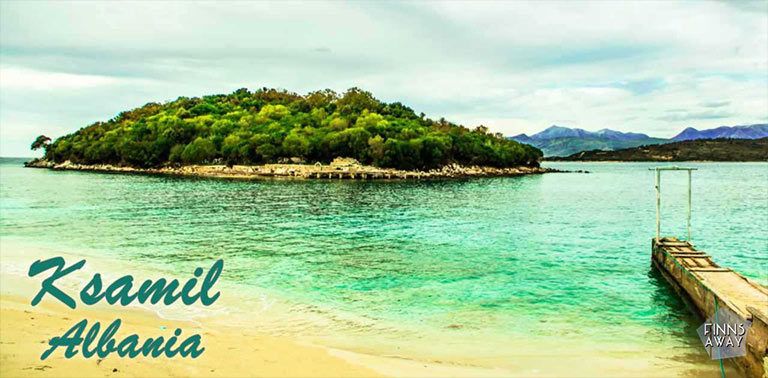
Ksamil, Butrint and the Blue Eye
In the last part of our post series about exploring Albania in December 2017 we introduce some of the gems in southernmost part of the country. After our road trip through Albanian riviera, we stayed for a week in the village of Ksamil and the surroundings. Albania might be more famous for the beaches and the mountains, but there is for sure much to see also for those interested in history and culture.
The popular beach village Ksamil
Ksamil, about 15 km south from Sarandë, is the southernmost beach town in Albania. This village with just few thousand permanent residents comes to life during summer months and lures in more and more visitors every year. And no wonder; the waters are perfectly turquoise, coast line partly rocky, partly dotted with small sandy beaches, and there are picturesque small islands to explore just next to the shore.
The Greek island of Corfu is just a stone’s throw away, and a lot of day-trippers come from there to Sarandë, visiting Ksamil and the nearby sights on day trips. We would recommend a bit longer stay to be able to really enjoy the beauty of coastal Albania and the hospitality of the locals.
When we visited Ksamil in winter, the village was really quiet. We stayed in a very nice but affordable Apartment Skrapalli, hosted by a lovely elder couple. We had no common language with our hosts, but it didn’t matter really, we came along well without many words. Our small apartment was equipped with kitchen, which was pretty important, since all restaurants that had their door open, seemed to only sell coffee and other drinks during the winter. So we cooked all the food, worked few hours a day, had runs and walks along the shoreline and nearby roads, took a bunch of pictures and went to a small local gym. But the highlight of our stay was a visit to amazing Butrint.
The Ancient Town of Butrint
Five kilometers south of Ksamil lies the remains of age-old port city of Butrint. We have seen quite a few castle ruins and amphitheaters during our travels, so didn’t expect too much from this site before visiting. But Butrint was something different, a wonderful journey through the ages of history from 8th century BC to 16th century AD. The site is a testimony of Hellenistic, Roman, Byzantine, Venetian and Ottoman cultures and civilizations, it has seen the rise and fall of empires over three millennia. Besides the surprisingly well preserved ruins, there is a museum with chronological overview of the history of Butrint, from the Bronze Age to the late Middle Ages. According to legend, the city was originally founded as early as in 13th century BC by Trojan exiles Helenus and Andromache after the fall of Troy.
The first building you see when entering the site is a Venetian tower from 15th and 16th century, but otherwise the walking tour through the site takes you past the oldest ruins first and ends up in the awesome Venetian castle with the museum. Ancient theater from 3rd century, Roman baths, Babtistery with mosaic floor (most of the time covered in sand to preserve its condition), impressive remains of the Great Basilica, ancient city walls with gateways and carvings, palace ruins. The amount of the sights and the layers of history in such small peninsula is something unique. The site is equipped with delightfully informative signs explaining the history significance of the buildings and other ruins.
The Butrint archaeological park, which is UNESCO World Heritage site since 1992, is surrounded by the National Park of Butrint. So on top of being an ancient city, Butrint is a wetland area of international importance with diverse flora and fauna. You could spot dolphins in the Butrint waters, and turtles are often found in both, the wet and dry areas of Butrint park.
How to visit Butrint
The easiest way to visit Butrint is by a car, but it can be reached via public transportation as well. There is a regular bus connection between Sarandë and Butrint, via Ksamil. The trip takes around half an hour from Sarande and costs less than 1 EUR. During summer there are also organized tours available. It’s very well possible to see both Butrint and the beaches of Ksamil on a day trip (either DIY or organized) from Corfu if starting early in the morning. If you have more time, why not to stay for couple of days in charming Ksamil.
Some tips for your visit:
- Remember to pick up a leaflet with a map from the entrance (tickets to the site in 2017 were 700 ALL, which is around 5 EUR) and follow the walking paths according to it.
- Allow at least two hours for the visit, even more if you want to carefully explore the museum as well.
- The length of the walking tour is less than two kilometers, but there are some ascents and stairs. If visiting during summer the heat can be wearing, so carry some water with you and wear a hat. And good walking shoes are recommended.
- The site is becoming more and more popular, so if you want to explore it without crowds, avoid the busiest summer weeks (especially August). On a sunny day in December we got the whole site to ourselves.
Syri i Kalter, the Blue Eye
Another popular sight near Sarandë is the Blue Eye Spring, Syri I Kalter. We had seen some pictures of the pond, which is supposed to look like an eye with iris and pupil of different colors. We almost skipped the site, but when driving past it anyway, decided to take a look. And I’m happy we did, since the whole place is really beautiful. The colors of the pond truly are fascinating, and the water is perfectly clear. But what makes the spring so unique is the unknown depth of the under-water cave (more than 50 meters) and the huge pressure of it; the spring pumps up 18,4 liters of drinkable water per second!
How to visit the Blue Eye?
At the time of writing, there was no direct public transportation to Syri i Kalter. It is situated about 20 kilometers east of Sarandë, on the road to Gijirokastër. The cheapest way to visit is to take a Gijirokastra bound bus from Sarandë, hop off in the crossroad to the Blue Eye (you can tell the driver that you want to go to Syri i Kalter) and walk the remaining 2 km to the spring. During summer there are also a lot of organized tours to this sight, or you could hire a vehicle with driver or use taxi. The ticket to the site is 50 ALL, so less than 0,5 EUR per person (2017). If you want to drive all the way to the spring along an unpaved road, you need to also pay 100 ALL for the vehicle.
The site itself is not big, so you don’t need to reserve much time for the visit. But for those interested in seeing more the surrounding nature, there are some walking tracks to explore. There are some restaurants and souvenir shops, and even cabins to rent if you want to stay overnight. During winter pretty much everything seemed to be closed, and we didn’t even need to pay for the entrance. Still the spring surely was as beautiful as it is during summer, just no other visitors around spoiling the pictures :).
Related post: Summary and costs of a month in Albania




